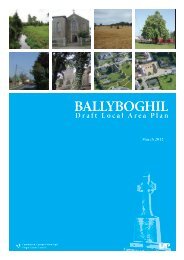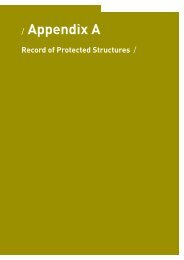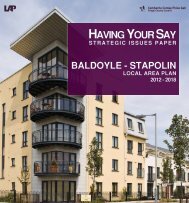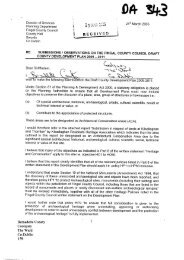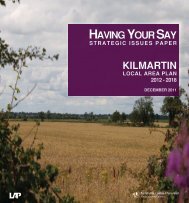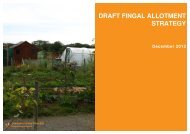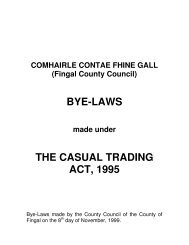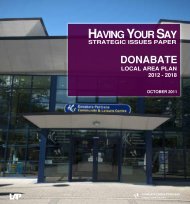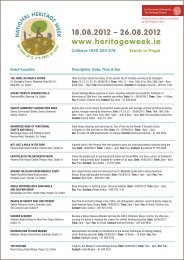Swords Masterplan - Fingal County Council
Swords Masterplan - Fingal County Council
Swords Masterplan - Fingal County Council
You also want an ePaper? Increase the reach of your titles
YUMPU automatically turns print PDFs into web optimized ePapers that Google loves.
3.4.2 CIVIC/COMMUNITY<br />
S W O R D S M A S T E R P L A N<br />
Urban Design Principle Issue Urban Design Guidelines<br />
Architectural<br />
Features<br />
Many older properties along Seatown Road have a vertical emphasis<br />
to their character, with good solid to void ratios and architectural<br />
features of merit.<br />
Ensure the following in new developments to respect the existing character of Seatown Road:<br />
Building Proportion<br />
• A high solid to void ratio in all new buildings.<br />
• Vertical window forms should be promoted to enhance the vertical emphasis.<br />
Roofs and Chimneys<br />
• Roofs should always span the shortest plan dimension to avoid excessively large roof spans.<br />
• Roof pitches should generally be between 30°-35°.<br />
• Lean-to roofs should be of equal or lower pitch than the main roof.<br />
• Roof profiles other than pitched are encouraged in the design of civic and community buildings.<br />
• Promote the use of a gable roof styles on proposed new residential uses to reflect the prevailing roof profile.<br />
• Discourage the use of gambrel/mansard or bonnet type roof profiles.<br />
• Retain existing chimneys, even if not in use, and new chimneys and repairs should match the traditional details.<br />
• Avoid the standard modern box eaves with deep projecting fascia, flat soffit and projecting barge boards.<br />
Shop fronts<br />
• Modern interpretations of traditional shop front details are particularly welcomed along Seatown Road.<br />
• Ensure fascias should not be greater than 1 ⁄5th of the height of the shop front (as measured from cornice to floor)<br />
Security Shutters<br />
• Where possible shutters should be contained inside the shop behind the window display, so that the shop front and its contents are still<br />
visible after opening hours.<br />
• The colour of the internal shutters should not cause them to detract from the character of the building or the area and should be dark in<br />
colour so that they are less visible from a distance.<br />
Shop Signage<br />
• New signage should respect the character and style of the building in terms of design and materials<br />
• New signage should not obscure architectural features such as windows and other shop front details<br />
• Avoid large area of glossy or reflective materials<br />
• Avoid excessive signage, projecting elements and clutter<br />
• When designing signs consideration should be given to colour and type of lettering.<br />
• On signboards, the lettering should not exceed ¾ of the depth of the fascia.<br />
• Generally banner advertisements shall be prohibited along Seatown Street.<br />
Canopies<br />
• Canopies should be made from traditional canvas and located directly below the fascia.<br />
• They should not extend across the pilasters or obscure architectural detail<br />
• The preferred canopy for <strong>Swords</strong> shall be the rigid traditional type<br />
• Frilled pelmets around the base of the canopy will not be accepted<br />
• Curved Dutch and balloon canopies are to be avoided as they are not traditional to <strong>Swords</strong> and provide minimal shading and shelter.<br />
Hanging and Projecting Elements<br />
• Projecting or hanging elements should be located at fascia level, their height should be not more than that of the fascia, and generally should<br />
not harm the appearance of the rest of the shop front.<br />
• In general no more than one hanging sign per shop front will be permitted.<br />
Lighting<br />
• Lighting should be considered as part of the overall shop front design rather than as an ad-hoc addition.<br />
• Lighting sources should be concealed, and carefully directed at the main signage.<br />
Outdoor Seating Areas<br />
• Outdoor seating areas should be located outside/clear of the lines of main pedestrian movement.<br />
• All emergency exits and routes must be kept clear.<br />
• When in use the outdoor seating area will need to be enclosed, to demarcate the area which contains the tables and chairs, thus making it<br />
distinguishable from other footpath users.<br />
• Planters can be particularly attractive and can be used as part of the means of enclosure, but may need to be removed from the footpath<br />
outside of trading hours.<br />
• The furniture should be of a high quality and uniform style within the area.<br />
• Where umbrellas are used these must be fabric type (i.e. non reflective). Umbrellas are to be positioned so as to avoid overhanging outside<br />
the enclosure or impairing.<br />
2 4




